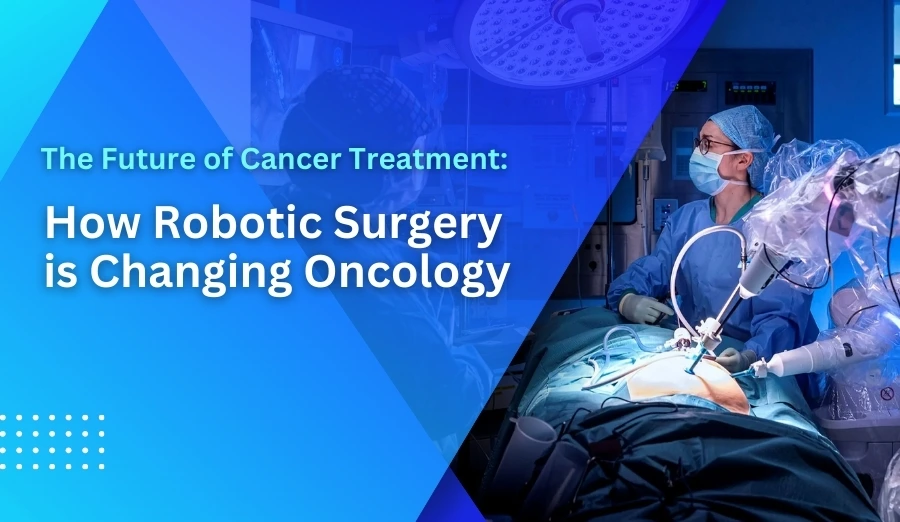-
BP Poddar Hospital
BP Poddar Hospital

Hello Reader!
Welcome to the blog page of Dr. Sunny Khanna, one of the best Surgical Oncologist in Kolkata.
Cancer treatment has witnessed a revolutionary shift with the advent of technology. As we step into a new era, Robotic Surgery and AI in cancer treatment are at the forefront, promising to redefine the Future of Cancer Treatment. As an oncologist in Kolkata, I, Dr. Sunny Khanna, am excited to share insights into how these advancements are transforming oncology.

Robotic Surgery involves using robotic systems to perform surgical procedures with high precision. These systems are controlled by surgeons and offer enhanced dexterity, allowing for minimally invasive operations. In cancer treatment, robotic surgery has become a game-changer, especially for complex procedures where precision is paramount.
The integration of AI in cancer treatment is another pivotal development. AI algorithms can analyze vast amounts of data, aiding in early detection, diagnosis, and personalized treatment plans. Here’s how AI is shaping the Future of Cancer Treatment:

Robotic surgery is making significant strides in treating various types of cancer:
While the Future of Cancer Treatment with robotic surgery and AI holds great promise, there are challenges to address:
AI is transforming robotic surgery in cancer treatment, significantly enhancing the precision, efficiency, and effectiveness of surgical procedures. This integration of technology is reshaping the future of cancer treatment by providing innovative solutions that improve patient outcomes. Here’s how AI is making a difference in robotic surgery for oncology.
One of the primary advantages of robotic surgery is its ability to provide enhanced precision during surgical procedures. AI algorithms can analyze real-time data from various sources, including imaging systems and intraoperative metrics. This capability allows for:
One of the critical challenges in cancer surgery is ensuring that all cancerous tissue is removed while preserving healthy tissue. AI plays a crucial role in addressing this issue:
The combination of AI and robotic surgery creates a powerful synergy that enhances surgical capabilities:
AI’s ability to analyze large datasets allows for a more personalized approach to cancer treatment:
The integration of AI into robotic surgery represents a significant advancement in the future of cancer treatment. As technology continues to evolve, we can expect:

Robotic surgery has become an increasingly popular option in the treatment of various cancers, offering a minimally invasive approach that enhances precision and reduces recovery times. Here are some of the most common cancers treated with robotic surgery:
Robotic-assisted prostatectomy is one of the most well-established applications of robotic surgery in oncology. This procedure allows for the precise removal of the prostate gland while preserving surrounding tissues and nerves, which can help maintain erectile function and urinary continence. The da Vinci Surgical System has become the gold standard for this type of surgery, providing improved outcomes and reduced complications compared to traditional open surgery.
Robotic surgery is widely used in treating various gynecologic cancers, including:
Robotic techniques are increasingly applied in colorectal surgeries, enabling surgeons to perform complex resections with minimal invasiveness. This approach helps reduce post-operative pain and recovery time while maintaining high levels of precision during tumor removal.
Robotic surgery is utilized for early-stage lung cancer treatments, including robotic lobectomies (removal of a lobe of the lung). This technique allows for better visualization and access to difficult-to-reach areas within the thoracic cavity.
Robotic-assisted nephrectomy (removal of the kidney) is another common application. This procedure minimizes trauma to surrounding tissues and allows for quicker recovery times compared to traditional open surgeries.
Robotic surgery can be employed for both total and partial bladder removal, as well as reconstructive procedures following bladder cancer treatment. This minimally invasive approach reduces complications associated with open surgery.
Robotic techniques are also being used to treat cancers in the head and neck region, allowing for precise excision of tumors while preserving critical structures such as nerves and blood vessels.
Also Read: Restoring Confidence Through Oncoplasty: Transforming Lives After Breast Cancer

Recent advancements in nanorobotics are revolutionizing cancer treatment by enhancing the precision and effectiveness of therapies. Here are some of the latest developments in this field:
Nanorobots are being designed to deliver chemotherapy drugs directly to cancer cells while minimizing damage to surrounding healthy tissues. This targeted approach helps reduce the side effects commonly associated with traditional chemotherapy. Recent studies highlight the use of nanorobots that can transport drugs through the bloodstream and release them specifically at tumor sites, ensuring higher concentrations of medication where it is needed most.
Nanorobots are being developed to perform “smart chemotherapy,” which involves real-time monitoring of tumor responses and adjusting drug delivery accordingly. These nanobots can sense changes in the tumor microenvironment and release drugs in response to specific stimuli, optimizing treatment efficacy. This capability is particularly beneficial for managing dynamic cancer environments where treatment needs may change rapidly.
Advancements in nanotechnology have enabled the creation of nanobots equipped with biosensors for early cancer detection. These devices can identify biomarkers associated with cancer cells, allowing for quicker diagnosis and intervention. By detecting tumors at earlier stages, treatments can be initiated sooner, improving patient outcomes.
Nanorobots are also being explored for minimally invasive surgical applications. They can navigate through the body to locate tumors and perform precise surgical tasks without the need for large incisions. This approach reduces recovery time and minimizes complications associated with traditional surgery.
The integration of AI in nanorobotics is enhancing their capabilities in cancer treatment. AI algorithms can analyze data from nanobots in real time, enabling them to make autonomous decisions about drug delivery and navigation within the body. This synergy between AI and nanotechnology is expected to lead to more sophisticated treatment options in the future.
While the potential of nanorobotics in cancer treatment is immense, challenges remain. Issues such as biocompatibility, immune response, and efficient navigation within the complex biological environment need to be addressed for successful clinical application. Ongoing research is focused on developing nanobots that can effectively operate within the human body without triggering adverse reactions.

Robotic surgery is increasingly being recognized for its advantages over traditional surgical methods, particularly in terms of patient recovery. Here’s a detailed comparison based on the latest findings:

Robotic surgery involves using advanced robotic systems controlled by surgeons to perform precise and minimally invasive cancer surgeries.
Robotic surgery offers greater precision, reduced recovery time, and fewer complications, leading to improved patient outcomes.
While not all cancer types are suitable, robotic surgery is commonly used for prostate, gynecological, lung, and colorectal cancers.
AI enhances robotic surgery by assisting in pre-operative planning, real-time decision-making, and improving accuracy during procedures.
Access may be limited due to the high cost and need for specialized training, but its availability is increasing as technology advances.
The convergence of Robotic Surgery and AI in cancer treatment is transforming the landscape of oncology, offering new hope to patients and enhancing the capabilities of healthcare providers. As these technologies continue to evolve, the Future of Cancer Treatment looks brighter, promising improved outcomes and personalized care.
At my practice in Kolkata, I, Dr. Sunny Khanna, am committed to embracing these advancements to provide the best possible care for my patients. By staying at the forefront of these innovations, we can work together toward a future where cancer is not just treated but conquered.

January 30, 2025

January 29, 2025

January 28, 2025